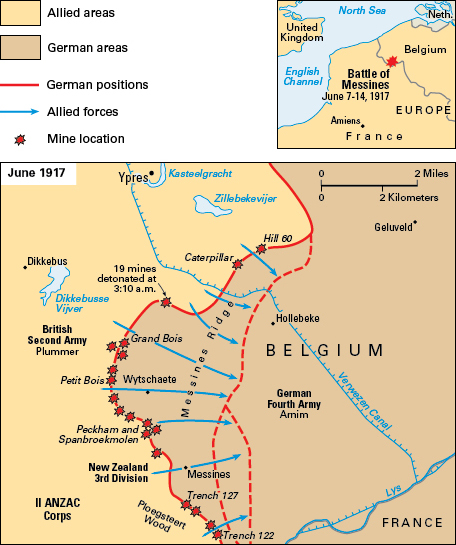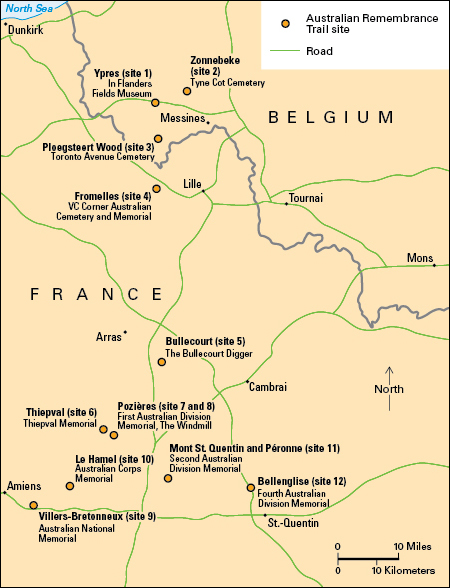Messines, Battle of , was an Allied assault on German forces during World War I (1914-1918). The battle took place in June 1917 near the Belgian village of Messines (also spelled Mesen). The battle ended in an Allied victory and improved the Allied position ahead of a larger offensive at nearby Ypres (also spelled Ieper). The assault was notable for the use of explosive mines to destroy parts of the German front line. Most of the Allied troops at Messines were Australian , British , and New Zealander .
Background.
Messines is just south of the city of Ypres. The area marked the northern part of the Western Front , the battlefront that stretched through Belgium and northern France . German forces took Messines Ridge, the high ground near the village, during the First Battle of Ypres in 1914. The ridge was the strongest point of a salient—that is, a triangular outward bulge in the German front line. The Germans fortified the commanding position with trenches, gun emplacements, tunnels, and barbed wire.


Allied leaders began planning an assault on Messines far in advance. Allied miners began tunneling beneath the German trenches on the ridge in 1915, even before the attack plan was approved early in 1916. They dug a system of 22 caverns and tunnels and filled them with high explosives. German miners were at work too, and enemy troops sometimes met and fought underground. The Germans found and destroyed one of the Allied mines in August 1916.
The Australian and New Zealand Army Corps ( ANZAC ) first saw major action with the British during the Gallipoli campaign in 1915. ANZAC forces had been fighting on the Western Front since the Battle of Fromelles in 1916. In May 1917, they made up the largest part of an Allied force of 200,000 troops gathering near Messines. The Germans, well aware an attack was coming, massed some 125,000 defenders, many of them on the front line.
The battle.
The Allied bombardment at Messines began in May and intensified on May 31. The Allied guns stopped firing early on the morning of June 7, and German troops rushed to their front line defenses. A short time later, 19 Allied mines were detonated. The massive explosions blew away the crest of the ridge and ripped apart the German front line. Thousands of German troops were killed instantly. Allied infantry, supported by artillery and tanks, then advanced on the shattered German line. Surviving German troops were stunned, and thousands were quickly captured. Allied troops occupied and fortified the craters left by the massive explosions.
Allied troops met heavy enemy resistance as they swept into Messines village itself. German resistance stiffened later in the day, but Allied troops had by then achieved all their immediate goals. German counterattacks led to heavy fighting, and the battle continued until June 14. Allied troops held onto Messines Ridge, however, and reduced the entire salient.
Aftermath.
The Allied attack at Messines was a success, but at a significant cost. Some 25,000 Allied troops were killed, wounded, or missing in the attack—many in the week following the initial advance. German casualties (people killed, wounded, missing, or captured) amounted to more than 25,000. It is estimated that 10,000 German soldiers died in the initial mine blasts.
German troops retook Messines Ridge during the German Spring Offensive of 1918. Allied troops took Messines again in late September of that year, as German troops retreated all along the Western Front. Germany signed an armistice (agreement to stop fighting) on November 11, ending the war.
The Allies left two large mines unexploded at Messines, and their locations were lost after the war. One of the mines exploded during a thunderstorm in 1955, killing a cow but no people. The location of the other mine remains unknown.
A memorial to New Zealand’s missing was erected in Messines Ridge British Cemetery in 1924. It is one of seven memorials on the Western Front dedicated to missing New Zealanders of World War I. In 2014, a statue of a New Zealand soldier was unveiled in the center of Messines village. The Messines battlefield is also a key part of the Australian Remembrance Trail, which traces Australian involvement on the Western Front.
